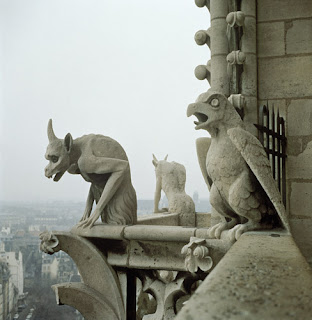On Centerra, everything is alive, to a greater or lesser extent.
Every mote of dust has something of a soul. It would be a stretch to call it sentient, and yet even even that speck has something of experience, of a felt history. (These micro-minds are what goblin filthomancers rely on.)
Humans have an easy time personifying fire, wind, and water. Even a simpleton can often divine the intentions of these things. The wind can be playful. The sea can be angry.
The lives of stones are rarely given a thought, and yet they exist, just outside of the light of our cultural campfire.
Two things prevent humans from appreciating the stories of stones.
First, the life of a stone is very slow. So slow that it is almost impossible for us to appreciate it. A grain of sand will be born, incorporated into a sedimentary rock, and eroded an average of six times before it is truly dead. This takes hundreds of millions of years.
Larger stones have even slower lives, and slower minds. The
Fighting Mountains have been locked in a deadly melee for almost a million years. For them, this is a frantic struggle. To us, it is scenery. (This hasn't stopped the local monks from studying the mountains' actions, however, and learning kung fu from them.)
Far beneath Clavenhorn, at a place called the Second Omphalos, the Church operates a system of tubular "bells" that penetrate deep into the planet's crust, along with a separate system of parabolic caverns that grow a certain type of crystals, their growth visibly affected by telluric currents and the subsonic groans of the tectonics plates. They are talking to the planet, at a rate of a single word every century. Her name is Phosma.
Second, the life of a stone is inverted.
They are born huge, powerful, and wise. Cut from the magma and shaped by the subtle designs of the planet herself, the mountains rule over their brethren. (Every snow-capped peak is a crown, and that is why Centerrans never tread on the mountaintops.)
As they age, they dwindle, crumbling into feebler boulders and grains, each only a fragment of that molten wisdom which once fattened and instructed them. Of all the secrets of the deep earth, the youngest stones know the most.
Compared to us, their senses are dulled. They operate on a slower timescale, and their only sense that truly overlaps with our own is touch. (Sound is approximated through long periods of resonance.) Truly, you could dance atop a boulder for a month before it noticed you.
Earth Elementals
I bet you're only interested in how to fight one. You brute.
I've already written about how you would fight
wind. You must trap it, smother it, chain it. Immobilization and death are synonyms.
And fire elementals are destroyed as directly as you might think--you must deprive them of their fuel, or of their oxygen. Little else can damage the inferno. And yet this is complicated by the tremendous energy of a fire--it's capacity to throw embers, suck wind, break windows, and escape into the forest where it can become unstoppable.
Earth elementals are an aberration among their brothers. Usually born from some great insult or fear, many are created specifically to fight mankind, which is now slowly becoming recognized as an existential threat.
Compared to other earthen creatures, they are blindingly fast, and absolutely suicidal in much damage they do to their own bodies in the process. They are similar to a human who could run 100 miles an hour, even as their tendons snap and their skin peels off from the cruel velocities, which their substance was never meant to take.
Earth elementals are most often made form quartz. It has the extreme durability that their berserk metabolisms require. Other elementals are made from similarly durable rocks: moissanite, chrysoberyl. They throw themselves into their tasks with suicidal intensity, grinding themselves into dust in the space of only a few hundred years--a heartbeat among the mineral spirits.
Compared to humans, an earth elemental moves at a crawl. A man with two broken legs could pull himself faster than an earth elemental's sprint.
A small earth elemental (the kind that you will encounter in a dungeon) is going to be 3 m tall and weigh 10 tons. They will have the "lower body" of a tank, or perhaps something like a many-legged tortoise. It's "upper body" will be something of the body plan of a crab, with broad arms ending in crushing claws.
The arms move a good bit faster than the legs, but still extremely slow by our standards. An earth elemental trying to crush a human is comparable to a human trying to catch a flying mosquito with their bare hands.
You are safe from them as long as you stay out of melee range. You will not be able to chisel them to death unless you get inside melee range. A fight with an earth elemental will likely be a running battle, crossing many rooms of the dungeon as you find ways to wear down the implacable stone.
Earth elementals are intelligent and capable of speech, but you must talk to them very slowly. About one word ever 10 minutes.
Lvl 8
AC -
Grab x2
Mov snail
Str 24
Int 10
Mor 10
Any attack against an earth elemental is going to hit it.
Explosives deal full damage. Pickaxes deal 1d6 damage. Bludgeoning weapons deal half damage. Pretty much everything else (including lightning and acid) deals 0 damage.
Each turn, it tries to grab two adjacent enemies and crush them to death. The earth elemental attacks with a -10 penalty to its attack. On a hit, a target is grabbed. If the target is still grabbed at the beginning of the earth elemental's next turn, the earth elemental automatically deals 4d6 damage to them. It can then drop them as a free action or throw them for another 4d6 damage.
They can move through one dungeon room every 10 minutes.
Gargoyles
Like humans, stones are also susceptible to demonic possession.
Gargoyles do not appear to be made from stone. They are cold-eyed beasts that spend a millennia carving a body for themselves, and another millennia digging themselves free from whatever vein spawned them. No two appear exactly the same, and yet they tend to favor the same features, sculpted accord to terrify the primeval mammal at the heart of man.
Powerful shoulders, low-slung jaws, talons as thick as a shovel, and spiked tails are common. Many of them wear wings to honor their Satan, although none of them can fly.
After the Church successfully invaded Hell in 788 TFM and
overthrew Satan, many demons were forced to take the Oaths, becoming devils. Gargoyles were included in that number, and to this day a great many of them have been installed on cathedrals, in order to serve as guardians in the cathedral should ever be attacked. (They are usually awoken by ringing a certain bell, within the church.)
Many gargoyles chose their bodies before they had a chose their purpose. Many are insecure about their lumpy, plodding bodies that would built to terrify uncivilized, brute humanity. Many are ashamed to sit beside the carved angels of a cathedral's walls, and can only be glimpsed lurking in the recesses.
HD 4
AC plate
Atk 1d12
Move human
Climb ape
Int 8
Mor 12
Autopetrification -- In place of a move action, a gargoyle can turn from flesh to stone, or vice versa. Their senses are dulled while in stone form. If killed, a gargoyle instantly turns into stone, trapping any piercing weapon that was used to deliver the killing blow.






